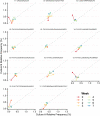Longitudinal TprK profiling of in vivo and in vitro-propagated Treponema pallidum subsp. pallidum reveals accumulation of antigenic variants in absence of immune pressure
- PMID: 34492041
- PMCID: PMC8480903
- DOI: 10.1371/journal.pntd.0009753
Longitudinal TprK profiling of in vivo and in vitro-propagated Treponema pallidum subsp. pallidum reveals accumulation of antigenic variants in absence of immune pressure
Abstract
Immune evasion by Treponema pallidum subspecies pallidum (T. pallidum) has been attributed to antigenic variation of its putative outer-membrane protein TprK. In TprK, amino acid diversity is confined to seven variable (V) regions, and generation of sequence diversity within the V regions occurs via a non-reciprocal segmental gene conversion mechanism where donor cassettes recombine into the tprK expression site. Although previous studies have shown the significant role of immune selection in driving accumulation of TprK variants, the contribution of baseline gene conversion activity to variant diversity is less clear. Here, combining longitudinal tprK deep sequencing of near clonal Chicago C from immunocompetent and immunosuppressed rabbits along with the newly developed in vitro cultivation system for T. pallidum, we directly characterized TprK alleles in the presence and absence of immune selection. Our data confirm significantly greater sequence diversity over time within the V6 region during syphilis infection in immunocompetent rabbits compared to immunosuppressed rabbits, consistent with previous studies on the role of TprK in evasion of the host immune response. Compared to strains grown in immunocompetent rabbits, strains passaged in vitro displayed low level changes in allele frequencies of TprK variable region sequences similar to that of strains passaged in immunosuppressed rabbits. Notably, we found significantly increased rates of V6 allele generation relative to other variable regions in in vitro cultivated T, pallidum strains, illustrating that the diversity within these hypervariable regions occurs in the complete absence of immune selection. Together, our results demonstrate antigenic variation in T. pallidum can be studied in vitro and occurs even in the complete absence of immune pressure, allowing the T. pallidum population to continuously evade the immune system of the infected host.
Conflict of interest statement
I have read the journal’s policy and the authors of this manuscript have the following competing interests: ALG receives funding for central testing from Abbott and research grant support from Merck and Gilead, unrelated to the work performed here.
Figures








Similar articles
-
Estimation of Full-Length TprK Diversity in Treponema pallidum subsp. pallidum.mBio. 2020 Oct 27;11(5):e02726-20. doi: 10.1128/mBio.02726-20. mBio. 2020. PMID: 33109767 Free PMC article.
-
Antigenic variation in Treponema pallidum: TprK sequence diversity accumulates in response to immune pressure during experimental syphilis.J Immunol. 2010 Apr 1;184(7):3822-9. doi: 10.4049/jimmunol.0902788. Epub 2010 Feb 26. J Immunol. 2010. PMID: 20190145 Free PMC article.
-
Gene conversion: a mechanism for generation of heterogeneity in the tprK gene of Treponema pallidum during infection.Mol Microbiol. 2004 Jun;52(6):1579-96. doi: 10.1111/j.1365-2958.2004.04086.x. Mol Microbiol. 2004. PMID: 15186410
-
Polypeptides of Treponema pallidum: progress toward understanding their structural, functional, and immunologic roles. Treponema Pallidum Polypeptide Research Group.Microbiol Rev. 1993 Sep;57(3):750-79. doi: 10.1128/mr.57.3.750-779.1993. Microbiol Rev. 1993. PMID: 8246847 Free PMC article. Review.
-
Biological basis for syphilis.Clin Microbiol Rev. 2006 Jan;19(1):29-49. doi: 10.1128/CMR.19.1.29-49.2006. Clin Microbiol Rev. 2006. PMID: 16418521 Free PMC article. Review.
Cited by
-
Characterization of Treponema denticola Major Surface Protein (Msp) by Deletion Analysis and Advanced Molecular Modeling.J Bacteriol. 2022 Sep 20;204(9):e0022822. doi: 10.1128/jb.00228-22. Epub 2022 Aug 1. J Bacteriol. 2022. PMID: 35913147 Free PMC article.
-
Bright New Resources for Syphilis Research: Genetically Encoded Fluorescent Tags for Treponema pallidum and Sf1Ep Cells.Mol Microbiol. 2024 Oct;122(4):455-464. doi: 10.1111/mmi.15304. Epub 2024 Aug 8. Mol Microbiol. 2024. PMID: 39115038
-
Syphilis vaccine: challenges, controversies and opportunities.Front Immunol. 2023 Apr 6;14:1126170. doi: 10.3389/fimmu.2023.1126170. eCollection 2023. Front Immunol. 2023. PMID: 37090699 Free PMC article. Review.
-
A novel pan-proteome array for high-throughput profiling of the humoral response to Treponema pallidum.iScience. 2024 Jul 31;27(9):110618. doi: 10.1016/j.isci.2024.110618. eCollection 2024 Sep 20. iScience. 2024. PMID: 39262771 Free PMC article.
-
Prevention strategies for sexually transmitted infections, HIV, and viral hepatitis in Europe.Lancet Reg Health Eur. 2023 Oct 26;34:100738. doi: 10.1016/j.lanepe.2023.100738. eCollection 2023 Nov. Lancet Reg Health Eur. 2023. PMID: 37927439 Free PMC article. Review.
References
-
- Centers for Disease Control and Prevention. Syphilis Surveillance Supplement 2013–2017. Atlanta, U.S.: Department of Health and Human Services. 2019.
-
- Savage EJ, Marsh K, Duffell S, Ison CA, Zaman A, Hughes G. Rapid increase in gonorrhoea and syphilis diagnoses in England in 2011. Euro Surveill Bull Eur Sur Mal Transm Eur Commun Dis Bull. 2012;17. - PubMed
Publication types
MeSH terms
Substances
Supplementary concepts
Grants and funding
LinkOut - more resources
Full Text Sources

